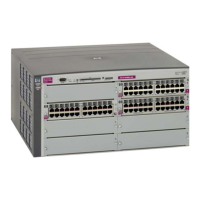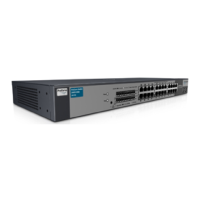VLANs 43
VLANs
Introduction
This chapter describes network design and topology considerations for using Virtual Local Area Networks (VLANs).
VLANs are commonly used to split up groups of network users into manageable broadcast domains, to create logical
segmentation of workgroups, and to enforce security policies among logical segments.
The following topics are discussed in this chapter:
• VLANs and Port VLAN ID Numbers
• VLAN Tagging
• VLANs and IP Interfaces
• VLAN Topologies and Design Considerations
NOTE: Basic VLANs can be configured during initial switch configuration.
More comprehensive VLAN configuration can be done from the command line interface. See the HP GbE2c
Ethernet Blade Switch for c-Class BladeSystem Command Reference Guide.
Overview
Setting up VLANs is a way to segment networks to increase network flexibility without changing the physical network
topology. With network segmentation, each switch port connects to a segment that is a single broadcast domain.
When a switch port is configured to be a member of a VLAN, it is added to a group of ports (workgroup) that
belongs to one broadcast domain.
Ports are grouped into broadcast domains by assigning them to the same VLAN. Multicast, broadcast, and unknown
unicast frames are flooded only to ports in the same VLAN.
VLANs and port VLAN ID numbers
VLAN numbers
The GbE2c supports up to 1,000 VLANs per switch. Even though the maximum number of VLANs supported at any
given time is 1,000, each can be identified with any number between 1 and 4095. VLAN 1 is the default VLAN, and
all ports are assigned to it. VLAN 4095 is reserved for switch management, and it cannot be configured.
Viewing VLANs
The VLAN information menu (/info/l2/vlan) displays all configured VLANs and all member ports that
have an active link state, for example:
>> Layer 2# vlan
VLAN Name Status Ports
---- -------------------------------- ------ ----------------------
1 Default VLAN ena 1 4-18 20-24
2 VLAN 2 ena 2 3
4095 VLAN 4095 ena 19
PVID numbers
Each port in the switch has a configurable default VLAN number, known as its PVID. This places all ports on the
same VLAN initially, although each port PVID is configurable to any VLAN number between 1 and 4094.
The default configuration settings for switches have all ports set as untagged members of VLAN 1 with all ports
configured as PVID = 1. In the default configuration example shown in the following figure, all incoming packets are
assigned to VLAN 1 by the default port VLAN identifier (PVID =1).

